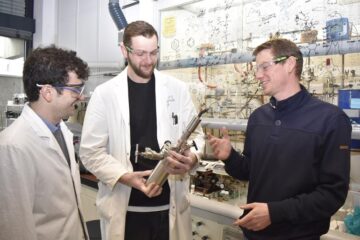Researchers improve detection of diverse anthrax strains

Scientists have capitalized on genomic data to define novel diagnostic tests and to gain insight into the evolutionary and genetic history of the deadly pathogen Bacillus anthracis (anthrax).
Researchers at Northern Arizona University (NAU), the Translational Genomics Research Institute (TGen) and The Institute for Genomic Research (TIGR) used nearly 1000 single nucleotide polymorphisms (SNPs) to define the genetic and evolutionary types of several anthrax isolates with extremely high resolution.
The results are scheduled for publication online this week by the journal Proceedings of the National Academy of Sciences.
“This level of detail is not possible without whole genome sequences from multiple strains,” said the paper’s senior author Dr. Paul Keim, Director of Pathogen Genomics at TGen and the Cowden Endowed Chair of Microbiology at NAU. “This work now provides the raw material for highly specific and sensitive tests for anthrax in human cases, animal cases and within the environment. Specific and sensitive tests for this pathogen are needed for effective bio-defense and forensic investigation into previous events.”
TIGR’s scientists sequenced the genomes of five isolates, or strains, of anthrax and then compared the results of each sequence to detect minute variations (SNPs). TGen and NAU researchers used that data to develop a typing, or identification, system for various anthrax strains.
“This is the first time that a new bacterial typing system has been developed from an analysis of multiple sequenced genomes of the same species,” said Dr. Jacques Ravel, who led the sequencing effort at TIGR. “Comparing the sequence of entire microbial genomes is helping scientists unravel the complex evolutionary history of this lethal agent.”
The SNPs described in this work were highly stable. Only one SNP was not entirely stable across the entire study, which means that diagnostic and forensic tests developed using this information will have extremely low false positive, or misidentification rates, a crucial criterion for advanced tests. False positives from anthrax environmental tests would have an inordinate impact on public health should an outbreak occur.
The work also shows for the first time that how researchers “discover” DNA fingerprints is crucial to what they can be used for. The selection of anthrax strains for whole genome sequencing was guided by prior work on the large global anthrax collection, which maximized the information that was ultimately obtained from the whole genome sequencing effort. Similar efforts without such forethought would be ineffective at defining major bacterial populations.
This study shows that diverse strains of pathogens will not be recognized unless they are contained within the scope for the discovery process.
“That the genetic relationships of anthrax have been defined to a new level of precision provides a critical step toward future detection of this potential public threat,” added Keim. “In addition, this study established a model for other biothreat pathogens, and common public health related diseases such as E. coli, Strep, Staph, and Salmonella.”
Media Contact
All latest news from the category: Life Sciences and Chemistry
Articles and reports from the Life Sciences and chemistry area deal with applied and basic research into modern biology, chemistry and human medicine.
Valuable information can be found on a range of life sciences fields including bacteriology, biochemistry, bionics, bioinformatics, biophysics, biotechnology, genetics, geobotany, human biology, marine biology, microbiology, molecular biology, cellular biology, zoology, bioinorganic chemistry, microchemistry and environmental chemistry.
Newest articles

Lower dose of mpox vaccine is safe
… and generates six-week antibody response equivalent to standard regimen. Study highlights need for defined markers of mpox immunity to inform public health use. A dose-sparing intradermal mpox vaccination regimen…

Efficient, sustainable and cost-effective hybrid energy storage system for modern power grids
EU project HyFlow: Over three years of research, the consortium of the EU project HyFlow has successfully developed a highly efficient, sustainable, and cost-effective hybrid energy storage system (HESS) that…

Safer alternative for an explosive reaction
The chemical industry has been using a reaction with explosive chemicals for over 100 years – now Mülheim scientists have discovered a safer alternative. The Ritter Group of the Max…





















